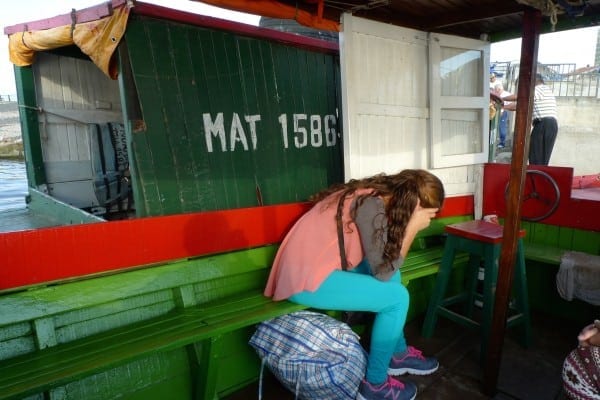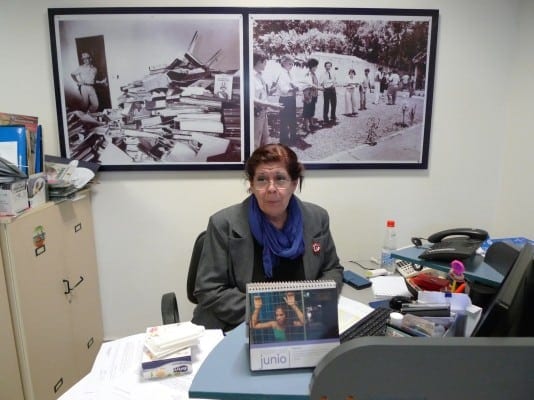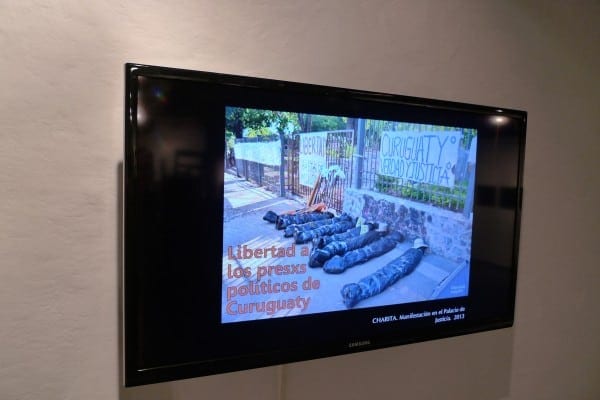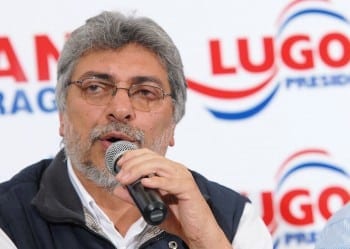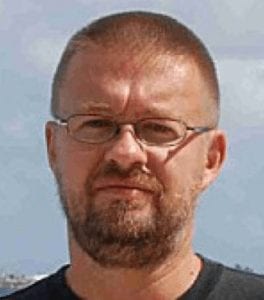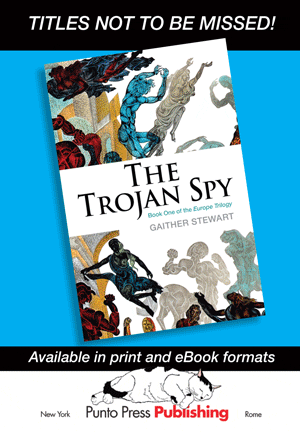They Say Paraguay is in Africa: Mosaic of Horror
ANDRE VLTCHEK | ROAMING CORRESPONDENT FOR THE LEFT
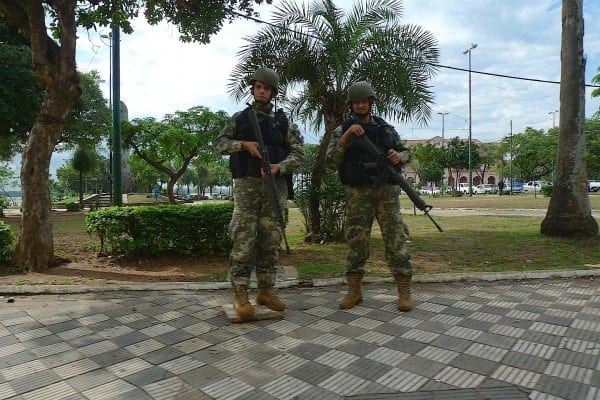
Welcome to Asunción. (All photos by the author unless noted otherwise/ Click to expand.)
[dropcap]I[/dropcap] have always liked this country of red earth, mighty rivers and rough cobblestone streets. I have liked its bougainvillea, its long silent nights, and its endless open spaces.
But almost everything that could went wrong for the Paraguayan people, or at least for its indigenous majority.
Before Evo Morales became the President, Bolivia had been the most destitute country in South America. Paraguay was slightly “above it” – the second poorest nation. Now, most likely, it is the most deprived.
***
It is pitch dark outside, and the road is flooded. As in other extreme right wing countries worldwide, from Indonesia to Kenya, the drainage system is far from being a priority of the rulers.
I am inside an impressive art museum, the Museo de Barra, a hangout of local intellectuals, most of them from the Left. Across the table from me sits Ms Lia Colombino, a curator and one of the museum directors. One floor below, a huge exhibition depicts the horrific massacre of indigenous people that took place at Curuguaty, in 2012. Powerful artwork is everywhere: photographs raw footage, and paintings.
Ms. Lia is clearly depressed about the state of her country:
“This does not look or feel like South America, does it? It is more like Central America…”
I know exactly what she means.
To me it still feels like South America, but long before the great wave of revolutions changed everything to the core. But I understand what she means. Paraguay does feels like Central America, like Honduras or Guatemala, where the indigenous people are treated with absolute spite, as “un-people”, where the owner of some plantation would not hesitate to blow out the brains of a ‘peon’, just because he is in foul mood or in need to flirt with a trigger. Two percent of the people in Paraguay own more than 75 percent of all the land. That says a lot.
“Paraguay could also be in Africa”, I was told by a Paraguayan doctor, aboard an airplane, en route from Buenos Aires to Asunción: “My country reminds me of some depressing, plundered sub-Saharan nation, still controlled by the West’s interests. I know what I am talking about; I spent several years in Africa. There I witnessed the same disrespect for human life as I am witnessing here.”
Next to my hotel, there is a huge Porsche showroom, and just a few minutes away, a luxury mall. “Shopping del Sol” is boasting its sleek modern design and luxury brands. But in both of its bookstores, not one single book by Eduardo Galeano or Elena Poniatowska could be found.
Right across the street from my hotel, there is a luxury steakhouse, but there is no way to cross the street, no zebras for pedestrians. Crossing is humiliating. Cars accelerate. If you don’t drive, you are treated like sub-human.
Modern skyscrapers are growing all around, but in between them, like in Indonesia, there are broken houses and shacks, dirty alleys and streets without sidewalks.
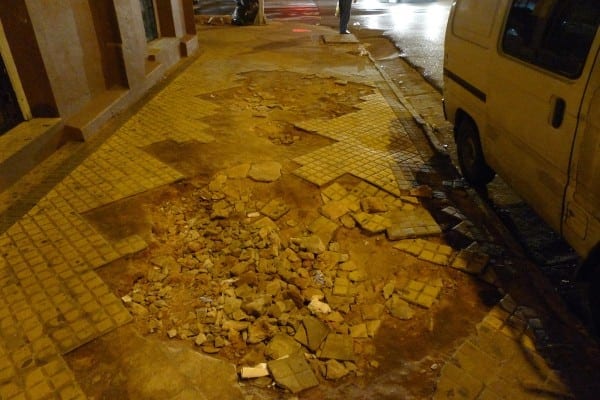
As in Jakarta, the sidewalks are a disaster.
All over the country, the descendants of European Nazis are still living in comfort, enjoying impunity and even respect. British and US intelligence facilitated the escape of thousands of notorious European Nazis to South America, often with the loot of golden teeth from the concentration camps, after they helped to break the left-wing political parties prior to post-war elections. It is believed that the notorious Hotel del Lago in San Bernardino (40 kilometers from Asunción) offered shelter to several prominent Nazis, including Joseph Mengele, the Angel of the Death, a German SS officer and physician in the Nazi concentration camp of Auschwitz-Birkenau.
But San Bernardino on Lake Ypacarai is now also notorious for shameless land grabs. There is hardly any public access to the lake, the shore being gradually ‘privatized’ by the country’s ‘elites’ and their ‘nautical clubs’.
The social situation in Paraguay is so bad that tens of thousands of its citizens are regularly crossing the border to much wealthier and to certain extent socialist Argentina, where they are provided with free medical care and free education for their children.
Hundreds of kilometers away from the capital, in the countryside, the mainly indigenous people are still living in the most horrific conditions.
Slammed in the middle of South America, Paraguay is a staunch ally of the West, surrounded by a rapidly changing, increasingly socialist part of the world.
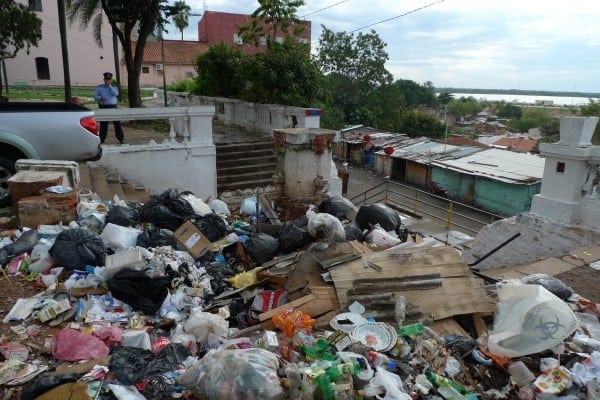
Extreme poverty side by side with wealth: slums of Asunción. This is the status quo Washington supports everywhere.
“Paraguay was the most violent and vicious dictatorship and the place of origin of Operation Condor in which many people from throughout the continent were tortured and killed. Paraguay is a vital and strategic location that sits over the largest fresh water aquifer in the world with very fertile lands. The population lives as sharecroppers in the countryside, similar to conditions found in the U.S. after the Civil War or worse”, commented Joseph J. García, Visiting Assistant Professor at the University of New Mexico.
“The social situation in Paraguay is so bad that tens of thousands of its citizens are regularly crossing the border to much wealthier and to certain extent socialist Argentina…”
The most vicious dictatorship… Perhaps it was, although in South America there had been many contestants to that sad prize.
On the ground floor of the Palace of Justice, Ms. Rosa M. Palau, coordinator of the “Center of Documentation and the Archive for Defense of Human Rights”, is bringing out one shocking historic document after another.
“Here, these are police archives… all that you see here, passed through the military intelligence. You can read here about all that dirty work done by the police… “Operation Condor”… There is some correspondence between the US and the regional governments. In these papers you can read about the ‘education’ that the US provided to the local police, as well as about the centers of torture in Asunción.”
I am in the middle of what is called “Archives of Terror”, an enormous quantity of documents, and part of The Memory of the World Programme of the United Nations Educational, Scientific, and Cultural Organization (UNESCO). According to the UNESCO:
“The Archives of Terror are official documents of police repression during the thirty-five years of Alfredo Stroessner’s dictatorship. They also contain supporting evidence of Operation Condor activities as a part of a campaign of political repressions involving assassination and intelligence operations which was officially implemented in 1975 by the right-wing dictators of the Southern Cone of South America.”
[dropcap]T[/dropcap]he Archives describe the fates of countless Latin Americans who had been secretly kidnapped, tortured, and killed by the security services, military and police of Argentina, Bolivia, Brazil, Chile, Paraguay, and Uruguay, mostly on behalf of US foreign policy, and, naturally with full US support. This is the barbaric and coordinated action of terror known as Operation Condor.
According to the archives, 50,000 people were murdered, 30,000 people disappeared and 400,000 were imprisoned. Many of those imprisoned were tortured and raped.
Sitting here, surrounded by files and papers, I kept recalling those days, some two decades ago, when the archives were made public, for the first time, in the suburb of Asunción called Lambare. All of us, who came to investigate, from different parts of Latin America and the world, were overwhelmed, emotionally and professionally. What we had always suspected was suddenly in front of us, black on white, proof after proof, showing that the United States, together with the local elites who were backed by ‘security’ services, had been systematically liquidating people guilty of harboring desires to live in just, egalitarian and socialist fatherlands.
We were all taking notes, photographing, going page after page through the horrifying evidence. Some people sat on the floor, squeezing their heads between the palms of their hands. Others were crying.
One day, a lawyer, a friend of mine, approached me in a neighborhood cafeteria. He sat next to me, and slowly declared:
“Do you think that anything changed in Paraguay? They, those responsible for the horrors, are looking at you going through those documents, and they are laughing at you, because they know that nothing will ever change in this country. They are laughing at me, too. I was tortured savagely. They pulled my nails out and they broke my balls. And now, when I go to watch a football match at a stadium, I see them, my torturers, and there is nothing that I can do. We greet each other, politely. We pretend that everything is fine; that nothing really happened… And then, at night, I scream.”
As if reading my thoughts, Ms. Rosa M. Palau suddenly breaks the silence. She can hardly contain her emotions:
“This was a terrible chapter of our history! Later, so many things happened, during the transition period. But now it is becoming obvious that we did not learn much about democracy. We learned almost nothing!”
***
Two successive coups – those in Honduras and Paraguay – are often quoted as proof that the United States never really ‘closed its eyes’ and let go of its perpetual victim – Latin America.
On 3 July 2012, Bill Van Auken published his analysis of the Paraguay coup at The World Socialist Web Site:
There is every reason to believe that the hurried impeachment of Lugo—forced through both houses of the Paraguayan parliament in barely 30 hours after he was charged by the two traditional parties of the country’s ruling oligarchy—was carried out with the indispensable complicity of US imperialism.
A former Catholic cleric and proponent of Liberation Theology, Lugo was elected in 2008, promising to combat corruption and promote “socially responsible capitalism.”
Committed to the defense of private property and with all the real levers of power remaining in the hands of the Liberals and Stroessner’s Colorados, who ruled the country for six decades before the 2008 election, Lugo was able to carry out little in the way of reforms, while he adapted himself continuously to Paraguayan reaction.
Nonetheless, the ruling oligarchy as well as the transnational agricultural interests found his presidency intolerable, fearing that it was generating false expectations among the masses of Paraguayan workers and oppressed. In particular there was concern that masses of landless peasants, receiving nothing in the way of genuine agrarian reform from the government, would take matters into their own hands…
The principal pretext for the impeachment was a massacre unleashed by Paraguayan security forces as they attempted to evict some 100 peasant farmers occupying the land of a wealthy former Stroessner-era Colorado politician. Eleven peasants and six policemen were killed, while scores more were wounded and arrested. The right-wing parties in the Paraguayan Congress blamed Lugo not for gunning down peasants, but for failing to carry out more thorough repression.
Ms. Clyde Soto, a social researcher at “Centro de Documentacion y Estudios” (CDE) in Asunción, spoke to me about the events of 2012 that began with the massacre at Curuguaty:
“The massacre of 15 June 2012 was well planned. It was performed in order to expel the farmers who decided to occupy the lands, demanding agrarian reform. Farmers knew that these were the lands unjustifiably seized by Blas N. Riquelme and his company Campos Morombi, with long and entangled legal process behind the case; the systematic strategy of seizure of land and territories still belonging to farmers and indigenous people. This plan was identical in substance to what was taking place throughout the history of post-colonial state of Paraguay (where definition of “post-colonial” is highly questionable). The second objective of the massacre was to create “space” for a “soft coup”, which removed Fernando Lugo from power, through a political trial full of irregularities. What happened in Curuguaty was clearly serving the interests of the powerful and of the business, both legal and illegal.”
Then she added:
“On Saturday, June 27, early in the morning, a group of farmers from Curuguaty once again occupied lands of Marina Kue, where the massacre took place in 2012. They are demanding both clarification of what happened 3 years ago, and the land titles.”
It appears that Paraguay is, once again, reaching the boiling point. People are now ready to fight, to risk their lives. Political and economic elites lost their trust, fully. And so the land is being taken over by farmers, at several locations.
One evening Mr. Fernando Rojas gave me a lift. He and his comrades from “Decidamos” (the citizens’ campaign “We will decide”) were heading north, to yet another area where farmers dared to take a decisive action and occupy the land that used to belong to them.
“We have to monitor what is going on in the provinces”, explained Fernando. “To make sure that what happened in Curuguaty will never happen again.”
The same night, at the Museo de Barro in Asunción, a film about the massacre at Curuguaty is screened. It is called “Fuera de campo”, directed by Hugo Gimenez, who is actually present at the screening.
Fuera de campo is a minimalistic, honest, experimental piece of art. On the screen, people are speaking slowly, decisively. Farmers are still protesting, still dreaming about better fatherland… a mother remembering her son, his love for this land: “We have to resist… If they kill us, then let them do it!” There are shots of injured police, being taken away by the ambulances… while injured farmers are being executed, point blank.
***
“Two weeks ago, the military was marching here, during the anniversary of the Military Academy of Paraguay. They were marching shoulder to shoulder with the US military personnel that is operating in this country”, recalls Ms. Rosa M. Palau.
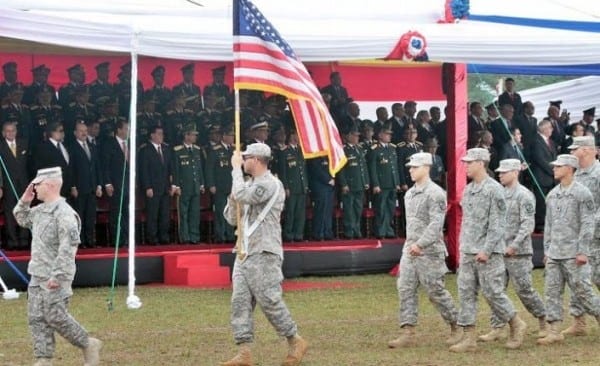
The Yanks are around. Brainwashed or indifferent imperial soldiers carrying out missions for the sake of the world’s oligarchs, but convinced they are defending “freedom” or stopping drugs.
There could be no doubts that the United States is trying to solidify its military and economic presence in this region, antagonizing progressive neighboring nations like Bolivia, Brazil and Argentina.
The US presence in Paraguay consists of the military and air force bases, and of surveillance bases used for spying on the countries of the region.
As clearly shown in the “Archives of Terror”, the US has, historically, great links with both Paraguayan elites and its military; links that have been used for torturing, assassinating and imprisoning tens of thousands of South American patriots.
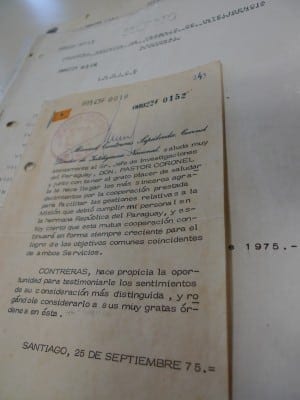
Document linking Chile’s terrorist police chief, Manuel Contreras, to the South Cone’s US-sponsored anti-left murder campaign, Operation Condor.
The US is regularly conducting secretive operations, particularly in the areas near Bolivian border, and also in the space where Paraguay, Brazil and Argentina meet.
There is already a huge US military air force base in Mariscal Estigarribia, Paraguay, which is located just 200 kilometers from the border with Bolivia and may be utilized by the US military in case that there is a US-backed coup against the socialist government of Evo Morales in Bolivia. That base is capable of housing over 16.000 troops. Near Mariscal Estigarribia are Bolivia’s natural gas reserves, the second largest in Latin America. The area has also huge significance, as the Guarani Aquifer is one of the world’s largest reserves of water.
Two years ago, Nikolas Kozloff wrote for Al-Jazeera:
“Recently, a host of individuals and organizations throughout Latin America called attention to the tumultuous state of politics in Paraguay, where democratically elected President Fernando Lugo was impeached by the country’s Congress under somewhat dubious circumstances. In a letter of protest, the signatories sketched out a rather inflammatory theory. They claim, for example, that the US Southern Command wanted Lugo gone as the Paraguayan leader who had opposed US militarization in his country.
“We already know who overthrew Fernando Lugo and why,” they added. “El Chaco … cannot be allowed to belong to [Paraguay]… nor its people; [the region has] been bound for occupation and extraction by multinationals through megaprojects and terror financed with public resources. The coup in Paraguay, like similar ones throughout Latin America, was carried out by and for multinationals and their partners among the local elites.”
Fernando Lugo was not really a socialist. He was never in the same league with Chavez, Morales or Correa. He is a liberation theology priest, a former bishop. After he was deposed, he did not leave the country, eventually becoming a senator. But even his center-left government became intolerable for the US interests and for the Paraguayan ‘elites’.
Ms. Lilian Soto, former Presidential Candidate, and foremost Paraguayan socialist politician and feminist described to me the unsettling political situation in her country:
“These days, in Paraguay, political leaders are defending interests of big businesses and their owners; consequently, they are ruling our country in a way that serves these interests and not the interests of Paraguayan people. These leaders are pushing for extreme consumerism, promoting deals that are serving interests of big multinational corporations, putting at risk our national sovereignty, allowing foreign military interventions, unleashing so-called ‘war against drugs,’ which turns itself into the excuse for the presence of the American armed forces in Paraguay. This radically reverses the relationship between the USA and Latin America, back to the point of direct military interventions, similar to what used to happen to Paraguay during the Cold War in the 70’s, when Paraguay used to be a pillar of the US aggression in the region.”
***
[dropcap]I[/dropcap]n the 1990’s, as a young journalist, I had witnessed several joint operations of the Paraguayan military and the agents of the US Drug Enforcement Agency (DEA). Twice I flew on board military helicopters to the border with Brazil, where several plants of marijuana were burned just for the lenses of us – foreign correspondents.
It was all a charade, but it was well orchestrated. “War on drugs” was always one of the main ‘justifications’ and covers for the US military presence in Paraguay.
Now “War on terror” is added to the list. In the tri-border region (Paraguay, Argentina and Brazil), around Ciudad del Este, several thousands of citizens of Syrian and Lebanese origin are accused of collecting funds for Hezbollah in Lebanon, an organization loved in Lebanon but hated in the West, consequently appearing on the US terrorist list. The US ‘feels obliged’ to monitor the situation.
In reality, what is at stake is the very independence of Latin America and its revolutions. The US is attempting to destabilize countries like Venezuela, Bolivia, Ecuador, Brazil and Argentina, through cooperation with local ‘elites’, but also through its military bases in Colombia, Guyana and Paraguay.
In the process, millions of poor, mainly indigenous people, are being sacrificed.
Ms. Rosa M. Palau is lamenting:
“Here, again, poor people who are mostly indigenous are fully exposed, unprotected. We all know that the US is involved. On this rapidly changing continent, Paraguay is becoming an isolated country.”
![]()
[printfriendly]
REPOSTERS NEEDED. APPLY HERE!
Get back at the lying, criminal mainstream media and its masters by reposting the truth about world events. If you like what you read on The Greanville Post help us extend its circulation by reposting this or any other article on a Facebook page or group page you belong to. Send a mail to Margo Stiles, letting her know what pages or sites you intend to cover. We MUST rely on each other to get the word out!
And remember: All captions and pullquotes are furnished by the editors, NOT the author(s).
What is $5 a month to support one of the greatest publications on the Left?
